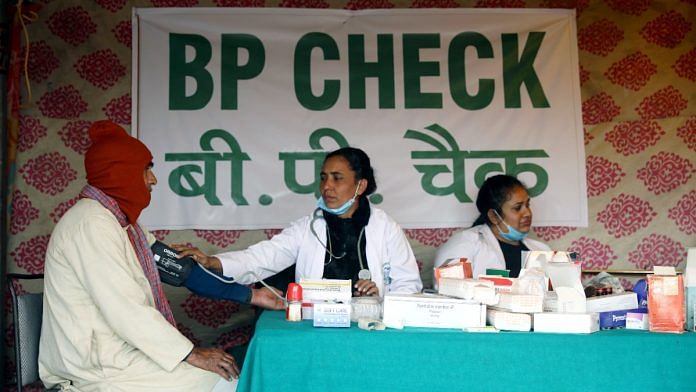New Delhi: Self-measured blood pressure (SMBP) monitoring is known to be an effective way of reducing systolic blood pressure (SBP) — the pressure exerted by blood against the artery walls when one’s heart beats. SBP is higher than diastolic blood pressure, which is the pressure in arteries when one’s heart rests between beats.
A randomised clinical trial by researchers at the University of California San Francisco (UCSF) has now concluded that when it comes to SMBP, a simple sphygmomanometer (an instrument to measure blood pressure) is just as effective as an ‘enhanced’ Bluetooth device connected to a paired smartphone.
Blood pressure monitoring is important for anyone with a known history of hypertension since, unchecked, it could lead to cardiac events or a stroke.
“We conducted a large simple pragmatic randomised clinical trial to compare the effectiveness of two currently available strategies for managing uncontrolled BP: SMBP using a standard device, or SMBP using an enhanced device with a connected smartphone application,” the researchers wrote while reporting the findings in the peer-reviewed journal JAMA Internal Medicine published by the American Medical Association Monday.
Over 2,100 participants enrolled in the study and, the report added, the sample was “large, with representation of Black and Hispanic/Latinx patients”. Half the participants were mailed a basic cuff, while the rest received a Bluetooth-enabled device to monitor their blood pressure levels.
Its conclusion read: “Using clinic BP measurements from EHR [electronic health record] data for follow-up, we found no difference in SBP reduction; both groups had an apparent reduction of approximately 11 mm Hg from their baseline self-reported office SBP to their most recent office BP measurement.”
“We think this study is important because it provides practical real-world answers for doctors and patients,” said corresponding author and UCSF professor of epidemiology and biostatistics Mark J. Pletcher, MD, MPH.
Also Read: With ‘re-engineered T-cells’, US firm claims breakthrough in therapy for relapsed multiple myeloma
‘Cost issue with Bluetooth devices’
After six months, patients who received the basic cuffs had lowered their blood pressure by 10.6 mmHg, and those who used the smartphone app had lowered their blood pressure by 10.8 mmHg, according to BP measurements taken at doctors’ visits and recorded in electronic health records, UCSF wrote in a statement about the trial.
In the report, the researchers noted that the devices that “enhance standard SMBP with additional digital support from a paired and connected smartphone application are commercially available” and added that the use of this “functionality by patients does not require health system investment, and the devices are only slightly more expensive than standard SMBP device”.
Explaining how these work, the UCSF researchers wrote that these “devices transmit BP measurements via wireless connection to the patient’s smartphone, where they are processed in a smartphone application to support tracking, visualisation, interpretation, reminders (to measure BP and/or take medications), recommendations (for lifestyle interventions, medication adherence, or to discuss their BP with their clinician), and communications (eg, emailing a summary to a family member or clinician).”
According to Pletcher, not only is there a “cost issue” with the Bluetooth devices, but, he said, “the time and effort involved in connecting them to a smartphone is really not trivial. As it turns out, there doesn’t appear to be any benefit to any of that. What seems to matter is engagement and support from healthcare providers.”
For a person exhibiting the first signs of raised blood pressure, keeping a daily diary to monitor BP is often the key to deciding whether they need medication or merely lifestyle modifications.
(Edited by Amrtansh Arora)
Also Read: Men have a ‘biological clock’ too — even their fertility declines with age. What you can do



